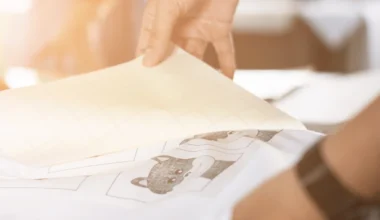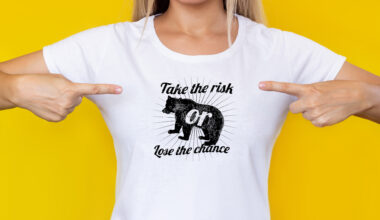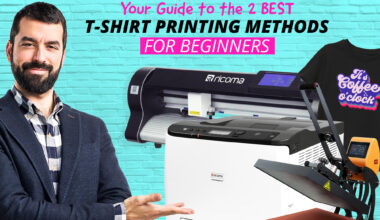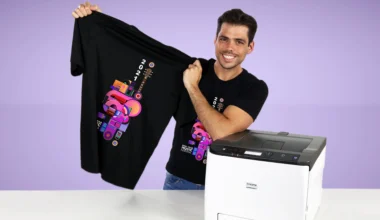Whether you’re passionate about graphic designs, quirky slogans, or artistic prints, turning your creativity into a thriving business begins with careful planning and a solid strategy.
Here at Ricoma, we believe in helping you start your t shirt business (or whichever creative business you want to start) with a community by your side! Let’s help you dive into how to start a t shirt business that you love!
How to Start T-Shirt Business (From Scratch)
Starting a t-shirt business can be an exciting venture, especially if you have a passion for design and entrepreneurship. To start t shirt business, here’s what you should do:
Find Your Niche
Before diving into designing t-shirts, take time to define who your ideal customers are. Are they young adults who love streetwear, or maybe parents looking for cute kids’ tees? Look for those untapped opportunities in the market.
Maybe there’s a niche for eco-friendly fabrics or shirts with inclusive sizing that you could explore.
Or, perhaps you just want to make t-shirts for babies… or dogs!
Finding these gaps can give you a competitive edge. It can help you while you study what other t-shirt businesses are doing.
Conduct Market Research
Gather insights into what your potential customers like so you can create t-shirts that resonate with them emotionally and aesthetically.
If you’re learning how to start a t-shirt business specifically for dogs, what do their owners like? Something classy, cute, or bold? Or if it’s for babies, are they looking for the most organic fabrics, neutral colors, or dual-purpose options?
If you’re still at a loss for what to do, you can use surveys, online tools, or even casual conversations to gauge interest in your t-shirt designs. See what people are looking for, and what they wish they had that they don’t.
Create a Business Plan

Now that you have a fair grasp of your business, you’ll want to develop a unique brand identity that reflects your values and resonates with your target audience.
Your brand identity includes your logo, brand colors, and the overall feel of your brand. It’s what sets you apart from other t-shirt businesses.
You might want to start by answering a few questions, like:
- What are your sales targets for the first year?
- How do you plan to grow your business over the next five years?
- What will be your main promo platform? (TikTok, Instagram, blog, YouTube, etc.)
Get Permits, Licenses, and Other Requirements
Check local, state, and federal regulations for starting a clothing business. Different regions may have specific requirements, such as business licenses or sales tax permits, that you need to comply with.
Maybe the most fun part — naming your business — has to include legally registering it, too. This ensures that no one else can use your brand identity, protecting your intellectual property and brand reputation.
Create a Budget
Begin by calculating all the expenses you’ll incur upfront. Consider costs for equipment such as printing machines, inventory like blank t-shirts, and marketing materials, and overhead expenses like utilities and insurance. A spreadsheet can be a useful tool to list and estimate these costs.
It’s wise to allocate funds for unexpected expenses or slower-than-expected initial sales. This could include additional marketing efforts to boost visibility or cover unforeseen repairs or equipment replacements.
Setting aside around 10-15% of your total budget for contingencies is a good rule of thumb.
Keep a close eye on your income and expenses to maintain financial stability. Track sales, expenses, and any incoming payments diligently. This helps you identify any cash flow issues early and adjust your budget or operations as needed.
Set Up Your Workspace
Decide where you’ll base your operations. Options include working from home to save costs, renting a studio for dedicated space, or using a coworking space for flexibility.
Invest in necessary equipment such as desks, chairs, storage units for t-shirts and supplies, and production tools like cutting machines or heat presses.
Design your workspace to optimize productivity and workflow. Arrange equipment and supplies logically, ensuring easy access and minimal clutter.
Create Unique and Appealing Designs
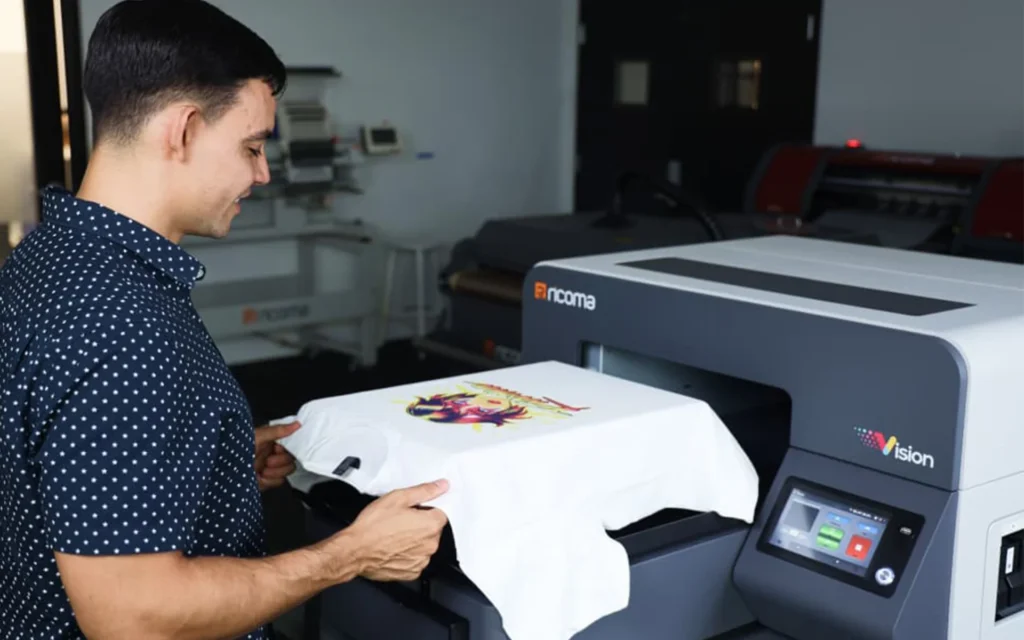
Choose a printing method that suits your design style and production volume. Options include DTG (Direct-to-Garment) printing for intricate designs and smaller batches as well as DTF, white toner transfer, and vinyl.
Select fabrics that enhance your designs in terms of comfort, durability, and printability. Cotton blends are popular for their softness and breathability, while polyester blends offer moisture-wicking properties ideal for sportswear.
Invest in premium materials such as embroidery threads and screen printing inks. High-quality materials ensure vibrant colors and durability, enhancing the perceived value of your t-shirts.
Get the Right Printing Machine
There are several methods available, each with its own advantages and considerations:
- DTG (direct-to-garment): Perfect for detailed designs or small batches, offering high-quality prints directly onto fabric. However, it can be slower and more expensive per print compared to screen printing.
- DTF (direct-to-film): Involves printing designs onto a special film, applying adhesive powder, and then heat pressing onto the garment. DTF offers good durability, vibrant colors, and works well for both light and dark fabrics.
- White toner transfer: Uses specialized white toner printers and transfer papers to create designs that can be heat pressed onto dark or colored garments. It’s great for small runs, offers a soft hand feel, and produces vibrant colors on dark fabrics without requiring pretreatment.
- Vinyl printing: Great for simple designs or text-based prints. It’s durable and offers a wide range of colors but may not be suitable for intricate designs.
- Sublimation: Best for polyester fabrics and allows for full-color designs with no texture or feel on the fabric. It’s ideal for all-over prints but requires specific fabric types.
You can easily browse through our printers, heat press machines, and sewing machines to see which one you might need to start off your business right!
As your business expands, investing in the right machinery can streamline production and increase efficiency — especially thinking about machines that offer bulk creation.
This might be a ways down the road but think about the near future for a bit. Here’s what you can look out for:
- Look at factors like order sizes, turnaround times, and seasonal fluctuations to determine your machinery requirements.
- Determine the financial benefits of investing in bulk production equipment. Calculate potential savings from reduced labor costs and increased output efficiency.
- If purchasing equipment outright isn’t feasible, look into leasing or financing options so you can spread costs over time while still benefiting from advanced production capabilities. Ricoma offers financing options specifically for this!
Join a Crafting Community Like Ricoma & Learn How to Start a T Shirt Business Right!
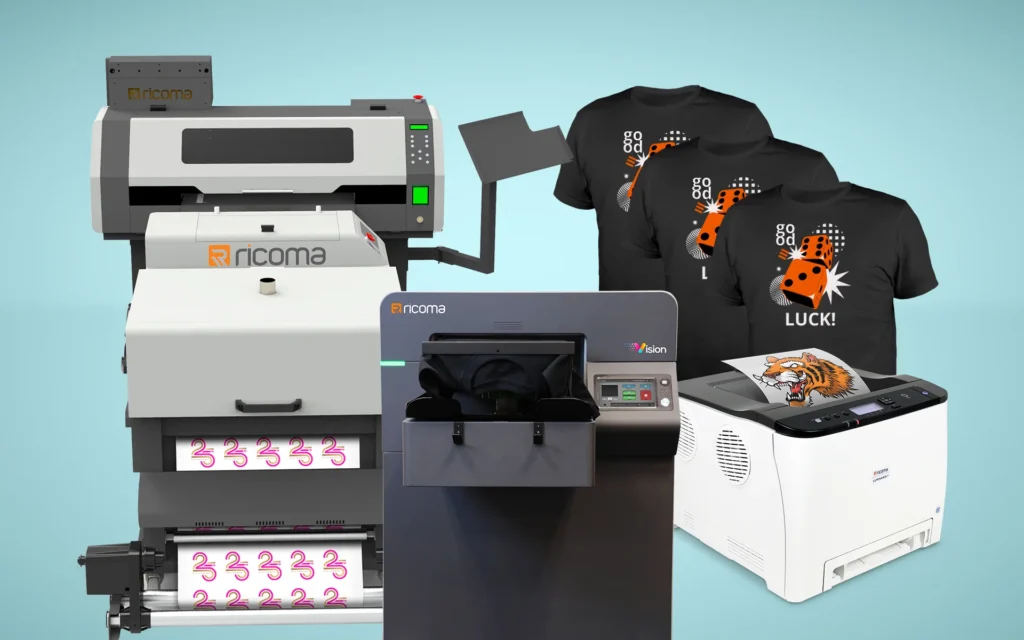
Building connections within the crafting community can provide invaluable support and growth opportunities when learning how to start a t-shirt business. Connect with industry professionals, discover new techniques, and stay updated on the latest trends.
Explore our printers and embroidery machines to find your perfect match!

